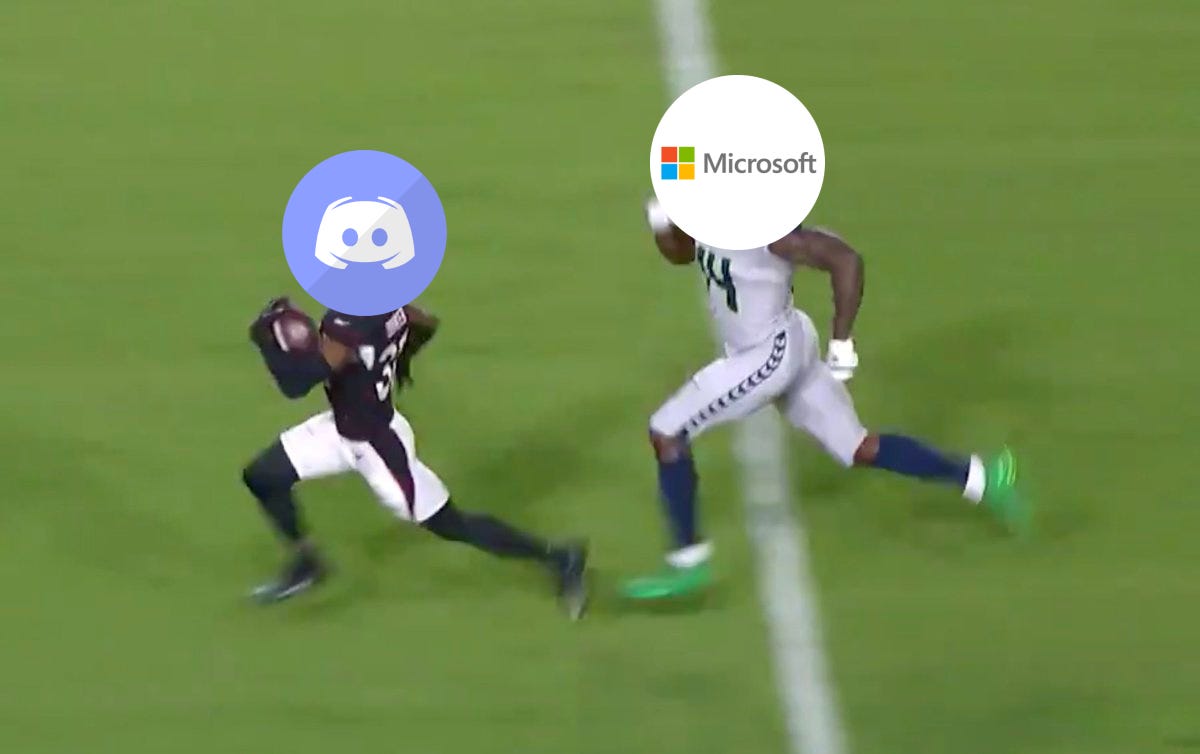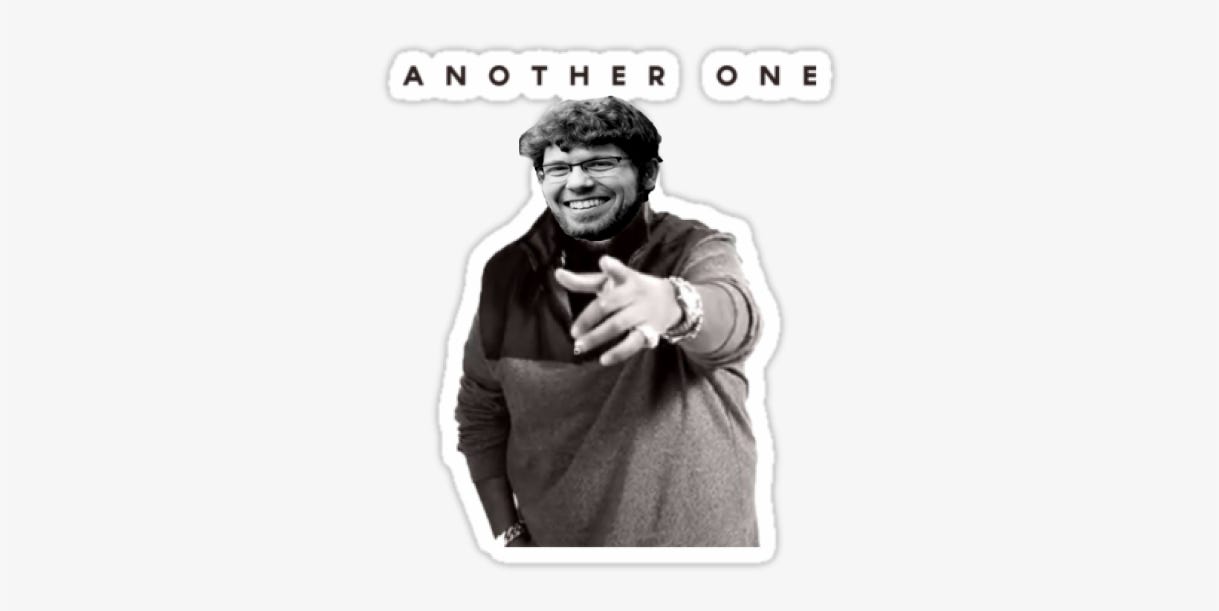🎮 Discord
Everything you *didnt* know about building Discord. This is a story of a game developer who is extremely talented at building mediocre games and pivoting them into successful software companies.
Hello folks 👋,
First of all, I would like to welcome the 981 new members to our little family 👨🏽🍼. We are now officially over 13,000 members ❤️. If you are a subscriber and want to get your company/project/yourself in front of the First 1000 audience, all you have to do is refer a few a people before the end of the month 🤪.
For more numbers and context of what’s happening behind the scenes on First 1000👇🏽
Today’s case study is on Discord. Discord is interesting…because for a decade I have brushed it off as a “Slack for gamers” platform. I underestimated the opportunity afforded by building a powerful a low latency, audio-first messaging platform.
Three weeks ago, Discord rejected Microsoft’s $12B bid to buy their company, and just earlier this week, Playstation (owned by Sony) announced a strategic partnership with the company. That got me wondering what is so special about Discord that got tech giants to go to the bitter end trying to catch a piece of this company. To answer that question, I decided to jump into the Discord story…First 1000 style 😉.
Let’s start from the very very beginning
The story of Discord is a story of platform shifts. Jason Citron started his career in game development studios creating some a few titles for Xbox and PlayStation 2 (that’s how old he is 😂) that you probably never heard of 😬.
Developing games didn’t really do it for him. The intermingling of excitement and disheartenment that comes with working 60-80 hours a week in a hit-or-miss business was ….brutal.
Platform Shift: Mobile
In 2008, the “app store” was just announced and Jason thought this would be the perfect time to take the entrepreneurial plunge. His thesis was that with the launch of mobile gaming on the iPhone he would get “free distribution” if he manages to become a “launch title” (ie develop his game before the app store is live). Whenever a new console comes out, there is always a new set of games that offer a new kind of experiences that are “native” to that console. This is one of very moments where new gaming behaviors are born….it was a once in a lifetime opportunity.
Jason raised some seed capital from the uncle of one of his roommates and was off to the races building Aurora feint. He pulled off being a launch title and the game was one of only 50 games that were available on the app store on the blessed day.
The Good News: it got rave reviews…partly because of the limited competition at the time, but also because Jason was an extremely talented game developer. A sneak peak into some of those headlines 👇🏽
"The most fun and addictive of the early iPhone games.“
“iPhone Apps We Like: Aurora Feint “
“Aurora Feint: A great iPhone game — and it’s free.”
The Bad News: the business model didn’t really work.
Aurora feint’s Business Model
The Business model for the game was very similar to other stuff that Jason had worked on in the past. He gave the game away for free and built a premium version that had multiplayer dynamics (such as competing with friends on leaderboards...competing in ghost matches....etc).
The $8 price tag (probably out of thin air) to access those social features didn’t really work. As time went by, and more games were built for the iPhone, and the price tag got anchored around at $0.99 - $4.99. Jason and his 5 person company made a meager $30k in revenue from this game….a far cry from a “hit” game.
With 3 weeks of runway left Jason hit up his dad to tell him
”I am coming home…get my room ready…this gaming thing just isn’t working”
The pivot to OpenFeint
One day, while discussing with the another founder, Citron realized that the iPhone did not have Xbox live in it, but their Aurora Feint 2 did have a similar feature. From my very shallow understanding Xbox live is just a platform that allows gamers to play multiplayer games, communicate with each and discover new games.
In an act of desperation, Jason decided to spin out those social features and sell them to other developers, in an attempt to become equivalent the Xbox live for iPhone….the only problem was he didn’t really have any money to pay his engineers let alone hire new ones to build this in time…or anyone for that matter….to get
Jason put up a landing page...photoshopped a couple of fake screenshots ...the message was "xbox live for mobile." He convinced Techcrunch to cover “the launch” and took that mailing list to investors…sprinkled some “vision” on it and raised a bridge round. He used the money from that round to hire 10 new developers to actually build the product
Deep dive:Sell Build Ship vs Build Sell Ship 🧐
The journey of building a startup usually goes something like this. You have an idea you are really excited about, you build an MVP, you discover First 1000 and use some of its case studies to try to get some customers, you get some feedback from early customers, lose a lot of sleep, iterate on your product and by some miracle you find your way to something that actually works. But not all MVPs are created equally. The more crowded the landscape you’re going after, the higher “minimum viable” bar you have to meet. Similarly some customer segments such banks, developers and enterprise companies just have a extremely high threshold you need to meet in order for you to just have a conversation. Sometimes, like in the case of OpenFeint, your best foot forward is not to actually build an MVP but try to Sell something that doesn’t exist. 40-60 hours of work can get you some janky MVP or a kick-ass pitch, sometimes the best thing to do is to sell a dream and see if anyone will bite!The $104m payout
Over the next two years Openfeint took over Jason’s life. As someone whose life revolved around gaming, I can’t even imagine how it must have felt like to build the entire infrastructure for social gaming on the iPhone. It was everything any game developer could ever dream of. He got all the highs from seeing his customers games explode (and translate that into 💰💰💰 for Openfeint) and none of the lows with being in the hit or miss business. It was the perfect ordeal.
By 2010, Openfeint had more than 10 million users and was powering 30 of the top 100 games on the App Store. Next year the company was acquired by a Japanese company (named GREE…but thats not really important) for a whopping $104 million (for reference the company ever raised $3m).
When Jason signed on the dotted line, it was under the expectation that he will now have the resources to build the Xbox live for mobile. Openfeint was his one shot on goal (or so he thought) and he wanted to take it TO THE MOOON (🐶). But as with many acquisitions…the story took a sour turn after the deal closed…
I thought I was gonna stay on and build a bigger thing but ultimately we (himself and GREE management) didn’t see eye to eye and I “left” after only 3-4 months. I remember that day I sat in the car and just cried....I didn’t know what I’ll do with my life now next.
- Jason Citron Cofounder of Discord & Openfeint
Rinse and repeat (for iPad)
Jason took a 7 months hiatus after being booted out of his own company. I was surprised to learn, however, that he didn’t go on a self-discovery journey in South-East like many of the great founders before him (looking at ya Steve Jobs 🧐). Instead Jason took the time-off playing video games….A LOT of video games.
Around that time, in 2013 the iPad was in its first years of inception and slowly making it to the main stream. While everyone saw iPad as a tablet, Jason saw it as a new platform shift for gaming…specifically for playing team-based games. He hypothesized that the iPad would make these kind of multi-player games more accessible and that the only problem was that there wasn’t enough high quality games being produced (spoiler alert: he was dead wrong 😬).
Ready for round 2…Jason started another company…this time named Hammer and Chisel. Hammer and Chisel was a game development house that focused exclusively on creating high-quality iPad games (you can think of it as the HBO of iPad games 😉). The vision for Hammer and Chisel was to replicate the Openfeint model for iPad. Jason wanted to build hit games that can get distribution through the App Store (because iPad was an afterthought for all the big gaming studios he saw a lot of leverage of getting featured there…plus he already had established credibility with Apple from his previous work.) He would then use this game to bootstrap an “Xbox live” for iPad (I never had an xBox in my life but must have been something if Jason was so obsessed with replicating that concept on any new platform for gaming that emerged 🙈).
Fates Forever
After a few hit-and-miss with launching different games (3 to be specific), Jason had Another ONE(idea) up his sleeve…this time for a game called Fates forever. In a true Sell-Build-Ship manner that we can come to expect from Jason, instead of putting in the hours to build a game and see it crumble in-front of his eyes, he, instead, chunked up the art ....and started posting it on reddit along with explaining how the “game worked”(there was no game at the time…just some art). He took feedback from and incorporated it into into the art and ultimately the game mechanics. Six months later, Fates Forever shipped to the app store, and yet again didn’t really live up to the expectations of Jason or the team.
The pivot to Discord
Jason was going around in circles trying to figure out how he can “fix” Fates Forever. In a conversation with Stanislav (Stan) Vishnevskiy (a developer at Hammer and Chisel then and cofounder of Discord later) Jason was complaining to Stan that the chat experience on Faints Forever sucked😣.
Stan was like yes the chat experience sucks in the game…but it also kinda sucks everywhere ….even on PC🤯. He then went on a rant explaining how the ideal communication platform SHOULD work for developers. And so the OG idea of Discord was born.
The idea was building Teamspeak meet skype. To take a step back Teamspeak was one of the more popular tools at the time used by gamers who played team vs team games. The problem with Teamspeak, at least from Stan’s prespective, was that to start a conversation on Teamspeak users had to download the app, pay for it and share their IP address (IP address is kind of like your mailing address) with other team members.
On the other hand, Skype which was a little bit more modern but the flow was really disruptive for gamers. If someone calls you in the middle of a game, it pops up on your screen, minimizes your game and in the middle of a heat-packed gameplay…that is the last thing you would want.
Stan made the case for building *yet another voice app* for gamers that would overcome all the limitations. Jason was onboard, after all this kind of fitted neatly into his “Xbox live” for iPad grand vision for the company. The only caveat was that they were no longer iPad exclusive, if they were going to build the best communication app for gamers…tthey had to do it where all the big gamers CURRENTLY where…and that is PC BABY.
After a decade of chasing new platform shifts and trying to capitalize on the free distribution and lack of competition associated with them….Jason was back to the place he most dreaded; competing in an extremely crowded space (communication for PC gamers).
Deep dive: Pivoting 🧐
The hardest thing about pivoting is acknowledging that thing you are working towards is not working. This is much easier to do, when you have some part of your product or a feature that is working (sort of what happened with Openfeint) and going all-in on that. But as we can see from the case of Discord, that is not always the case. For Jason he pivoted into a completely untested crowded territory….the only thing he had going for him was a very clear articulation of what is wrong with the current state of the domain he is pivoting into.Cutting through the noise
Jason and Stan started building the first version of Discord as a side project within the company. As you can probably tell Jason was obsessed with finding some distribution arbitrage (previously he focused on developing for new emerging platforms) but for Discord he needed a new angle….that angle was channel links.
People were not gonna download another voice chat.....there were so many competitors...teamspeak...mumble..etc. What we needed to do was make it really easy to join without the need to download yet another software and without sharing your IP address. During that time, WebRTC was becoming a part of the new web browser which made it possible to build Discord entirely on the web. You can use it by sending someone a link...they didn’t have to download an app...there was 0 friction.....with one click they were right in the conversation…no ip..no set up…and if they liked it...they can always download the app
- Jason Citron, Cofounder of Discord
With the mechanics (web links) of getting distribution built right into the app…now it was time to GET SOME CUSTOMERS.
Customers Customers Customers
First 20 customers
The first 20 customers for Discord were friends, friends and friends. For the first 5 months, Jason and Stan were building Discord and hammering their gamer friends to use it. Their friends signed up but weren’t actually really using the product. Everytime they asked them why, they highlighted that they needed this feauture or that feature. Stan and Jason would go build it and come back to them…they got excited for a minute and then demanded more features. This loop kept going on and on and at some point the team had spent 3 weeks not shipping anything, they figured that maybe Discord just wasn’t as important as they had previously thought.
First 200-300 customers
Those 3 weeks were yet another reminder to Jason of how important distribution was. He figured that gaming communities were far and wide on the internet and that the product was at a point where it could be stress-tested by more than just his unappreciative friends. So Jason and Stan got one of the friends to post in the Final Fantasy 14(a popular game at the time) subreddit. The reason they narrowed it down to this one specific game was that there was a new expansion (i.e new features, content..etc) coming out which meant that there was a lot of anticipation, speculation, and excitement about the new release on Reddit.
Their friend posted a simple link saying “"Hey...did anyone try this new voiceover IP app called discord [link to a voice chat].“ Jason and Stan immediately jumped onto the voice chat and started talking to anyone who showed up. The Redditors would go back, say "I just talked to the developers there, they're pretty cool," and send even more people to Discord. That kind of kicked the snowball off the top of the mountain.
Fun fact: Discord now claims this day (May 13, 2015) as their “launch day”
First 1000 customers
For the next 1000 customers, Jason and Stan focused all their product work on just 3 games, all of which had upcoming expansions (i.e new releases) in an attempt to make integrations with these games as seamless as possible. They then did the same Reddit routine, got a friend to post on the game’s subreddit asking if member had tried using Discord and accompanying that message a link to a voice chat where Jason and Stan were waiting to meet and greet and answer any questions anyone had.
To double down on that strategy, Jason and Stand started doing some 1:1 promotion with “guilds” of these games. Guilds are “an organized group of video game players that regularly play together in one or more multiplayer games. Many guilds take part in gaming competitions, but some guilds are just small gaming squads consisting of friends. “
It just so happen that Stan’s previous company was the largest social network and hosting company for these groups of gamers. The name of his startup was Guildworks and at the time it was getting millions of hits a month and had over 1000 sites hosted(for these groups). You can think of Guildworsk as Wix meets Facebook. With the social proof and credibility amongst these communities of gamers, as the cofounder of Guildworks…Discord wasn’t a very hard sell.
Discord eventually brought their grand vision of building a modern “Xbox live” to reality. They launched a Netflix-style games subscription service but eventually shut it down in 2019. Turns out…. just the communication piece of this grand vision that Jason has been pursuing for his entire life is worth at least $12b (and counting 😅)….who would have thought 🤷♂️…
This is it for today folks, see you next Sunday 😉,
Ali Abouelatta





